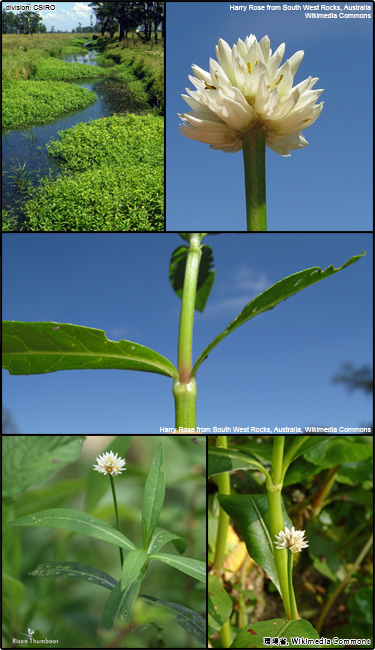Alligatorweed (Alternanthera philoxeroides)
 Synonyms: Achyranthes philoxeroides
Synonyms: Achyranthes philoxeroidesCommon Names: alligator weed, pig weed
Description: First recorded in Alabama in 1897. Possibly introduced through ballast water.
Habit: Emergent or rooted woody floating plant. Plants have hollow steams and can grow up to 3 ft. (1 m) tall.
Leaves: Opposite, elliptical, pairs or whorls, thick but non-succulent. Up to 4 in. (10 cm) long.
Stems: Hollow, growing up to 3 ft. (1 m) tall. Stolons can reach a length of 10 m.
Flowers: White in color, clover-like heads in the axils of the leaves. Occurres during the summer months.
Fruit and seeds: Very small, single-seeded. Typically non-viable.
Habitat: Native to South America. Can be found in wet soils or shallow water growing out into waterways. Can also grow on land.
Reproduction: Vegetatively as seeds are rarely produced.
Similar species: Marsh seedbox (Ludwigia palustris), Lake hygrophila (Hygrophila costata).
Monitoring and rapid response: Mechanical removal can be costly and potentially cause fragments to regrow. Bio-control methods have been successful with the use of the alligatorweed flea beetle (Agasicles hygrophila). Credits: The information provided in this factsheet was gathered from the Indian River Lagoon Species Inventory, Invasive Plant Atlas of the US, and the USDA National Invasive Species Information Center.
Individual species images that appear with a number in a black box are courtesy of the Bugwood.org network (http://www.invasive.org).Individual photo author credits may not be included due to the small display size of the images and subsequent difficulty of reading the provided text. All other images appear courtesy of Google (http://images.google.com).
Common Name: | Alligatorweed |
Scientific Name: | Alternanthera philoxeroides |
Family: | Amaranthaceae (Amaranth) |
Duration: | Perennial |
Habit: | Aquatics |
USDA Symbol: | ALPH |
